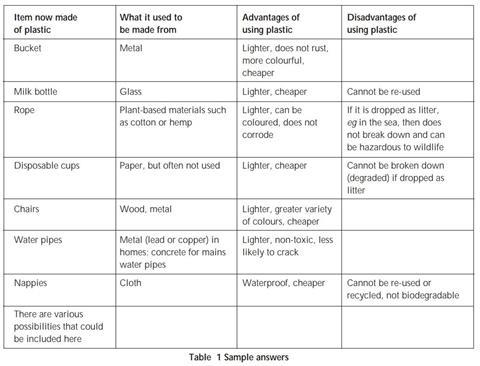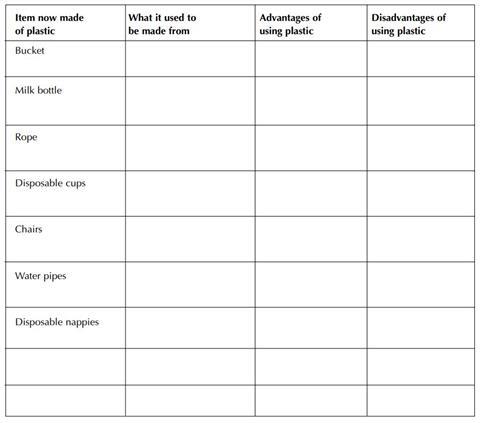What use is plastic?
This activity is intended as an introduction to work on plastics and polymers. It aims to get students thinking about the advantages as well as the disadvantages of using plastics. It could be set as homework or done as a group activity in class.

There are other possible answers that could be included in Table 1. The remaining questions can be used as part of a class discussion. Some points you may wish to consider are: The main advantage of plastics is that they are light.
This reduces transport costs and means that less petrol/oil is used to move them around than heavier materials. Many students do not appreciate this. The use of plastic parts in cars has greatly reduced their weight and contributed to the improved efficiency of modern cars. The main disadvantage of plastics is that they are often not biodegradable, so they remain in the environment when thrown away.
This is very noticeable in the case of rope. Rope made from plastics (often polypropene) is often washed up on beaches after having been in the ocean for some time. It can kill sea life. However, the longevity of plastics was initially seen by chemists as a real advantage.
For example, if a plastic is used for underground pipe work the fact that it lasts a long time means that it needs less frequent replacement, and less water is wasted as a result of cracks and leaks than might be the case with some other materials.
It is when we litter or are wasteful that the disadvantages of plastics become most noticeable. It might seem easy to say that we should not use plastic packaging at all, but without it far more food would spoil and become inedible before it could be used.
This would lead to greater fertiliser and pesticide use in an attempt to increase production to compensate for food wastage. This is a brief introduction to some of the complex issues raised in the activities provided within this resource that relate to polymers, plastics and the environment.
Degradable plastics
The aims of this activity are to:
- Consider what makes a plastic biodegradable
- Learn the difference between biodegradable and photodegradable plastics
- Consider the social and environmental consequences of using either degradable or non-degradable plastics.
The activity is aimed at able 14–16 year olds and would fit into a unit on plastics, polymers or the environment.
Two student sheets are required:
- Degradable plastics – worksheet including questions and a little information
- Degradable plastics – information sheet – more detailed background information;
Learners will need this sheet if they are to tackle all the questions on the Degradable plastics worksheet.
Degradable plastics – information sheet UK plastic facts:
- We produce three million tonnes of plastic each year
- Households are the biggest producers of plastic waste
- 60 % of household waste comes from packaging
- More than 80 % of this plastic is used once and then goes to landfill sites
Only 7 % of plastic is recycled. In addition to household waste, there is also the issue of plastic litter (mainly packaging) which is discarded in the environment. On land it is ugly but in the sea it can be deadly – it can cause injury and death to birds, fish and other sea creatures. Given all this, it is not surprising that people are concerned about plastic waste and are increasingly looking to scientists to produce a degradable plastic to help solve the problem.
However, there is much debate among scientists and environmentalists as to whether degradable or non-degradable plastic is better for the environment. The conclusions drawn by researchers studying this topic are not always what you might expect. To understand fully the effect a product has on the environment it is necessary to carry out a ‘life cycle analysis,’ which means looking at the impacts of production, use and disposal of the product.
There are two kinds of degradable plastic: photodegradable and biodegradable. Photodegradable plastic is usually made of oil-based polymers, just like ordinary plastic. It either has bonds in its structure that can be weakened and broken by sunlight, or it contains a chemical additive which absorbs light and then attacks the polymer and breaks some of the bonds.
Once a photodegradable plastic is exposed to light it begins to break down – whether you want it to or not. This can be disastrous if it is mixed in with other plastics during recycling. Photodegradable plastics tend to break down into small particles of plastic rather than decomposing completely. The idea is that these small pieces will then biodegrade. Unfortunately, they are often not biodegradable and so remain in the environment. The effect that a build-up of small pieces of plastic in the soil might have on the environment has not been investigated.
At present, most plastic waste ends up in a landfill site where it is buried in a dark hole in the ground. Under these conditions, photodegradation cannot take place. Biodegradable plastics can be made from oil or from plant-based products. They are attacked by bacteria, fungi or other micro-organisms which use them as food. The most commonly used plastics have been tested to find out whether they are biodegradable.
Polythene is biodegradable as long as its chains have a molecular weight of less than 500; most other polymers are not. Polyesters are susceptible to biodegradation but they are used very little in packaging materials. As the majority of plastic waste is from packaging, using polyesters will not really help solve either the problem of the large quantity of waste produced or that of litter in the environment.

- Add two other items that are now made of plastic to the table.
- What are the main advantages and disadvantages of using plastics?
- Plastics last a long time before they corrode. When is this an advantage and when is it a disadvantage?
Downloads
Plastics
PDF, Size 0.45 mb
Additional information
This resource is a part of our Inspirational chemistry collection.
Inspirational chemistry book

A collection of resources, aligned with GCSE bodies, to support learners in England, Wales, and N Ireland.
- 1
- 2
- 3
- 4
- 5
- 6
- 7
- 8
- 9
- 10
- 11
- 12
- 13
- 14
- 15
- 16
- 17
- 18
- 19
- 20
- 21
- 22
- 23
- 24
- 25
 Currently
reading
Currently
reading
Plastics
- 27
- 28
- 29
- 30
- 31
- 32
- 33
- 34
- 35























































































No comments yet